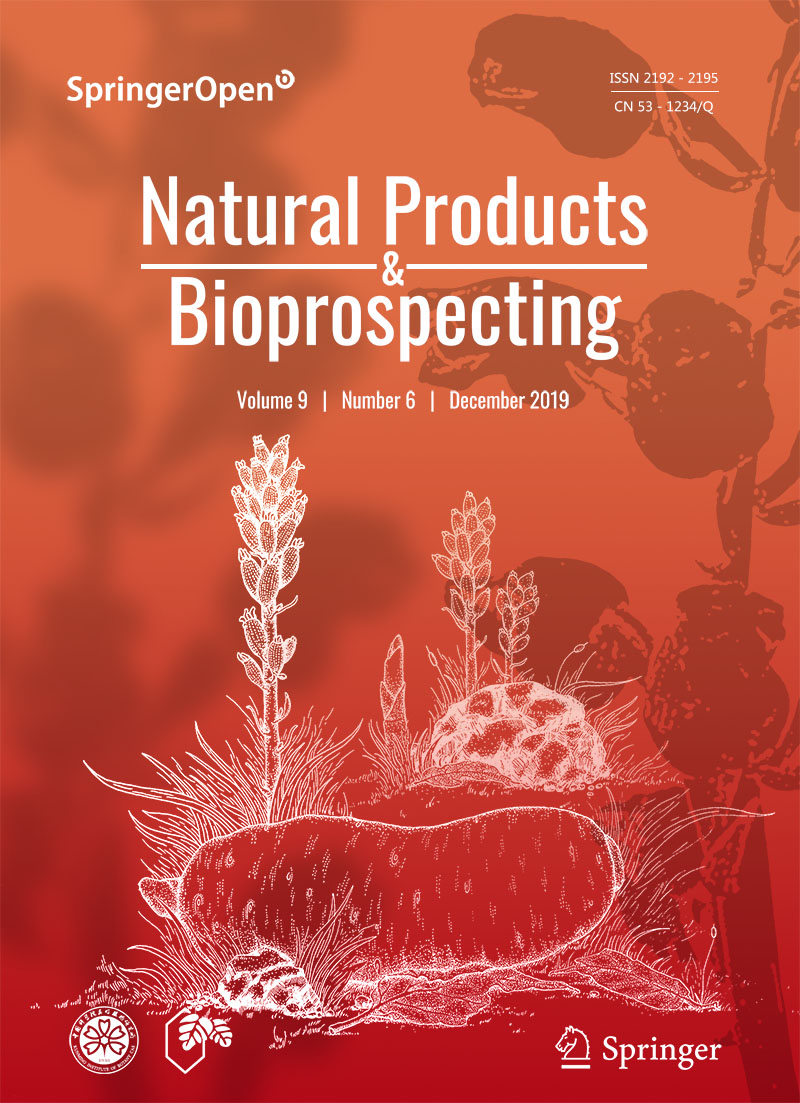|
|
The Genus Terminalia (Combretaceae): An Ethnopharmacological, Phytochemical and Pharmacological Review
Collect
Xiao-Rui Zhang, Joseph Sakah Kaunda, Hong-Tao Zhu, Dong Wang, Chong-Ren Yang, Ying-Jun Zhang
Natural Products and Bioprospecting. 2019, 9 (6): 357-392.
DOI: 10.1007/s13659-019-00222-3
Terminalia Linn, a genus of mostly medium or large trees in the family Combretaceae with about 250 species in the world, is distributed mainly in southern Asia, Himalayas, Madagascar, Australia, and the tropical and subtropical regions of Africa. Many species are used widely in many traditional medicinal systems, e.g., traditional Chinese medicine, Tibetan medicine, and Indian Ayurvedic medicine practices. So far, about 39 species have been phytochemically studied, which led to the identification of 368 compounds, including terpenoids, tannins, flavonoids, phenylpropanoids, simple phenolics and so on. Some of the isolates showed various bioactivities, in vitro or in vivo, such as antitumor, anti HIV-1, antifungal, antimicrobial, antimalarial, antioxidant, diarrhea and analgesic. This review covers research articles from 1934 to 2018, retrieved from SciFinder, Wikipedia, Google Scholar, Chinese Knowledge Network and Baidu Scholar by using "Terminalia" as the search term ("all fields") with no specific time frame setting for the search. Thirty-nine important medicinal and edible Terminalia species were selected and summarized on their geographical distribution, traditional uses, phytochemistry and related pharmacological activities.
References |
Related Articles |
Metrics
|
|
|
Gastrodin Derivatives from Gastrodia elata
Collect
Cheng-Bo Xu, Qing-Lan Guo, Ya-Nan Wang, Sheng Lin, Cheng-Gen Zhu, Jian-Gong Shi
Natural Products and Bioprospecting. 2019, 9 (6): 393-404.
DOI: 10.1007/s13659-019-00224-1
Nine new gastrodin derivatives, including seven p-hydroxybenzyl-modified gastrodin ethers (1-7), 6'-O-acetylgastrodin (8), and 4-[α-D-glucopyranosyl-(1→6)-β-D-glucopyranosyloxy]benzyl alcohol (9), together with seven known derivatives, were isolated from an aqueous extract of Gastrodia elata ("tian ma") rhizomes. Their structures were determined by spectroscopic and chemical methods as well as single crystal X-ray diffraction. Compounds 1-4, 7, 10, and 11 were also isolated from a reaction mixture by refluxing gastrodin and p-hydroxybenzyl alcohol in H2O. As both gastrodin and p-hydroxybenzyl alcohol exist in the plant, the reaction results provide evidence for the production and increase/decrease of potential effective/toxic components when "tian ma" is decocted solely or together with ingredients in Chinese traditional medicine formulations, though the isolates were inactive in the preliminarily cell-based assays at concentrations of 10 μM. Moreover, using ultraperformance liquid chromatography high-resolution electrospray ionization mass spectrometry (UPLC-HRESIMS), 4, 7, 10, and 11, as well as component variations, were detectable in the freshly prepared extracts of different types of samples, including the freeze-dried fresh G. elata rhizomes.
References |
Related Articles |
Metrics
|
|
|
Secondary Metabolites Produced by an Endophytic Fungus Pestalotiopsis microspora
Collect
G. R. Nalin Rathnayake, N. Savitri Kumar, Lalith Jayasinghe, Hiroshi Araya, Yoshinori Fujimoto
Natural Products and Bioprospecting. 2019, 9 (6): 411-418.
DOI: 10.1007/s13659-019-00225-0
An endophytic fungus Pestalotiopsis microspora isolated from the fruits of Manilkara zapota was cultured in potato dextrose broth media. Chromatographic separation of the EtOAc extract of the broth and mycelium led to the isolation of a new azaphilonoid named pitholide E (1), in addition to previously identified pitholide B (2), pitholide D (3), pestalotin (LL-P880α) (4), PC-2 (5), LL-P880β (6), tyrosol (7) and 4-oxo-4H-pyran-3-acetic acid (8). An endophytic fungus P. microspora from M. zapota and the isolation of compounds 1-5, 7 and 8 from P. microspora are reported here for the first time.
References |
Related Articles |
Metrics
|
|
|
Diterpenoid Alkaloids and One Lignan from the Roots of Aconitum pendulum Busch
Collect
Jun Wang, Xian-Hua Meng, Tian Chai, Jun-Li Yang, Yan-Ping Shi
Natural Products and Bioprospecting. 2019, 9 (6): 419-424.
DOI: 10.1007/s13659-019-00227-y
Diterpenoid alkaloids have neroprotective activity. Herein, three napelline-type diterpenoid alkaloids 1-3, two aconitinetype diterpenoid alkaloids 4-5, and one isoquinline-type alkaloid 6, as well as one lignan glycoside 7, have been isolated from the roots of Aconitum pendulum Busch. Compounds 1 and 7 were new compounds, and their chemical structures were determined on the basis of nuclear magnetic resonance (NMR) spectra and mass spectrometry analysis. A ThT assay revealed that compound 2 showed significant disaggregation potency on the Aβ1-42 aggregates.
References |
Related Articles |
Metrics
|
|
|
New Iboga-Type Indole Alkaloids from Tabernaemontana divaricata
Collect
Xiang-Mei Li, Xian-Jun Jiang, Guo-Zhu Wei, Li-Hua Ren, Li-Xia Wang, Xue-Lian Cheng, Fei Wang
Natural Products and Bioprospecting. 2019, 9 (6): 425-429.
DOI: 10.1007/s13659-019-00226-z
Two hitherto unknown iboga-type indole alkaloids, namely (3R)-7,19-di-epi-3-methoxytabernoxidine (1) and (3R,19R)-19-hydroxy-3-(2-oxopropyl)voacangine (2), together with eight known alkaloids (3-10), were isolated from the twigs and leaves of Tabernaemontana divaricata. Their structures were established on the basis of spectroscopic data interpretation, single crystal X-ray diffraction analysis and circular dichroism spectrum.
References |
Related Articles |
Metrics
|
|

